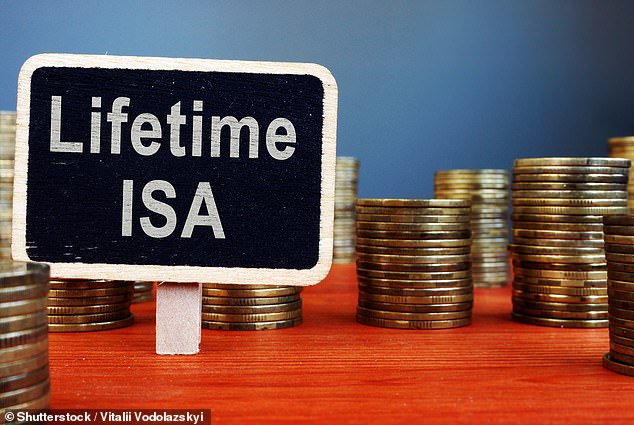Table of Contents
When Lifetime Isas launched in 2017, I wasn’t the least bit interested – I already own a house so I didn’t need it as a deposit and saved into my private pension. It seemed like a strange product.
Since then, I have found myself in a situation where I pay 15 per cent of my salary monthly into my private pension, made up of my own contributions and the employer’s contributions.
I don’t think I should put more in there and then I started thinking… should I max out a lifetime Isa each year to get the guaranteed 25 per cent bonus? And should my wife do it too?
Clearly, we would use this as part of retirement when we can access it at age 60.
We’re quickly approaching 40, so this is our last chance to get a Lisa. It’s worth it? Or would it be better to invest £4,000 a year elsewhere?
Tax benefits: All Lifetime Isa withdrawals are tax-free, while pensions only allow 25%
This is Money’s Harvey Dorset responds: It’s good that you are taking steps to ensure that your future is as secure as possible.
Deciding whether to use a lifetime Isa alongside your pension means you’re already on the right track.
The problem you face is establishing the potential benefits of each course of action (opening a Lisa, paying more into your workplace pension) or doing something else.
Each has its own benefits, and which one is right for you will depend on you and your wife’s circumstances.
Both you and your wife can pay up to £4,000 a year into a Lisa, although this reduces your £20,000 annual Isa allowance, and the government will reward you with a 25 per cent bonus on your savings.
This pales in comparison to the 40 per cent tax relief you will receive on pension contributions if you are a higher rate taxpayer. If, on the other hand, you are a basic rate taxpayer, your pension would only receive a 20 per cent relief.
But what about taxes on withdrawals? A Lisa will allow you to withdraw your funds tax-free (although you will be charged a fee if you withdraw before turning 60), while pension withdrawals are taxed as income.
On the other hand, pensions allow you to withdraw a 25 per cent lump sum tax-free, which could be more than the £40,000 you could save over the next ten years into your Lisa.
To that end, This is Money spoke to two financial advisors to find out what factors you should consider when deciding whether to open a Lisa or take an alternative route.

Age limit: Brian Byrnes says you can only withdraw from Lisa at 60, while pensions allow withdrawals at 55
Brian Byrnes, director of personal finance at Moneybox, responds: First, it’s great that you’re thinking carefully about your retirement savings.
It is crucial to address these things as early as possible in life and, as you will have identified, there are many products designed to help you achieve a comfortable and well-deserved retirement.
When looking at retirement savings products, it’s important to consider your workplace pension first for three main reasons.
Firstly, if you are a higher rate taxpayer (earning more than £50,270), you will get 40 per cent tax relief on your pension contributions, which is much higher than the 25 per cent bonus you get in the Lifetime Isa.
National Insurance is also not paid for pension contributions, so the tax relief ‘top-up’ may be significantly more attractive than the Lisa bonus for higher (and additional) rate taxpayers.
Secondly, making pension contributions through your salary is very easy from an administrative perspective and tax relief occurs automatically.
Thirdly, as you mentioned, you receive contributions from your employer to your pension, so it’s always worth checking whether you’ve maximized those contributions before looking for retirement savings elsewhere.
You mention that you think you should not invest more into your pension and it would be interesting to know why. The combination of employer contributions and tax relief is hard to beat elsewhere. Perhaps your employer is already paying the maximum amount.
If your wife is self-employed, Lisa may be an interesting option as she won’t necessarily have the benefit of workplace pension contributions.
If any of you are a basic rate taxpayer, you will still get basic rate tax relief (20 per cent) on your pension contributions.
Again, you also save on National Insurance contributions, so the general tax relief works in a similar way to the Lisa bonus.
It is therefore necessary to consider the wider features and benefits of pensions versus Lifetime Isa.
The main difference is the tax treatment at the time of withdrawal.
Pension income is taxable on withdrawal, while you can withdraw it from a tax-free Lisa.
While this may seem like a significant Lisa advantage over a pension, the latter has a 25 per cent tax-free lump sum and, like salaried income, your first £12,570 of income is taxed at zero per cent, so so much of your pension income can be effectively tax-free.
Therefore, it is difficult to make a direct comparison without knowing more about your and your wife’s financial situation.
It’s also worth noting that you can currently withdraw from a private pension at age 55, which will rise to age 57 in 2028, while you can’t withdraw from a Lisa for retirement purposes until age 60.
The contribution limits are also significantly different. The maximum contribution to a Lisa is £4,000 a year, while for a pension, you can contribute up to £60,000 a year.
In short, a lot will depend on you and your wife’s personal financial situation, particularly which tax band you are both in at the moment and therefore what tax relief applies to your pension contributions.
The answer may well involve both a Lisa and continuing your pension contributions. You can only open a Lisa until age 40, but if you pay £1 into a Lisa before you turn 40, you can continue making contributions until age 50.
So it might be wise to do so while you figure out which option is best for you, or keep the Lisa option if your circumstances change in the future.
Janice Dallas, independent financial advisor at Aberdein Considine Wealth, responds: There are a few things to think about when considering your question.
The “bonus” paid by the Government on lifetime Isa contributions is a flat 25 per cent for everyone. So, if you pay income tax of 40 or 45 per cent on some of your income, you can get a better “bonus” by paying more into your pension than into a Lisa.
You can only pay at Lisa up to age 50. If you’re in your late 40s, that means you could pay up to £40,000, with bonuses of up to £10,000. Then when you turn 60 you can access your money.

Investigate: Janice Dallas Says Charges for Different Products Could Hugely Change How Much You Have Left
There are fewer options available for Lisas on the market compared to other types of Isa. And if you are opting for Lisa stocks and shares and know what you want to invest in, check if these investments can be accessed through Lisa.
If inheritance tax is likely to be an issue for you, be aware that currently pensions do not normally form part of your taxable estate on death, while Isas do.
Inheritance tax aside, the end result of the same investment held in a pension or a Lisa over the same period will be influenced by three key things: tax relief or bonuses added to contributions paid; deducted product charges; and, fundamentally, the tax deduction when the funds are withdrawn.
Look at how your private pension charges compare to Lisa’s charges. Even a small difference in annual charges can have a pretty big impact on the bottom line.
If you can find a Lisa with similar product charges to your private pension, then it will be your tax situation that will make the difference, particularly taxes on withdrawals.
Under current rules, 25 per cent of a private pension can be withdrawn tax-free, with the remaining 75 per cent subject to income tax, while 100 per cent can be withdrawn from a Lisa pension tax-free .
So, while higher and additional rate taxpayers may get better ‘bonuses’ by contributing to a private pension, even basic rate tax deductions on 75 per cent of a pension fund in retirement will mean a lower net return than would be achieved with a tax-free Lisa.
DIY INVESTMENT PLATFORMS

AJ Bell

AJ Bell
Easy investing and ready-to-use portfolios

Hargreaves Lansdown

Hargreaves Lansdown
Free Fund Trading and Investment Ideas

interactive inverter

interactive inverter
Fixed fee investing from £4.99 per month

sax

sax
Get £200 back in trading fees

Trade 212

Trade 212
Free trading and no account commission
Affiliate links: If you purchase a This is Money product you may earn a commission. These offers are chosen by our editorial team as we think they are worth highlighting. This does not affect our editorial independence.
Some links in this article may be affiliate links. If you click on them, we may earn a small commission. That helps us fund This Is Money and keep it free to use. We do not write articles to promote products. We do not allow any commercial relationship to affect our editorial independence.


